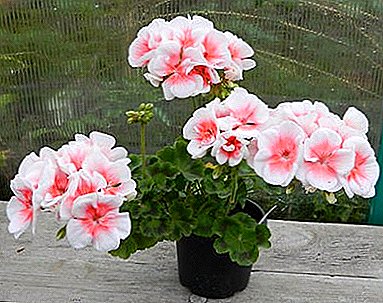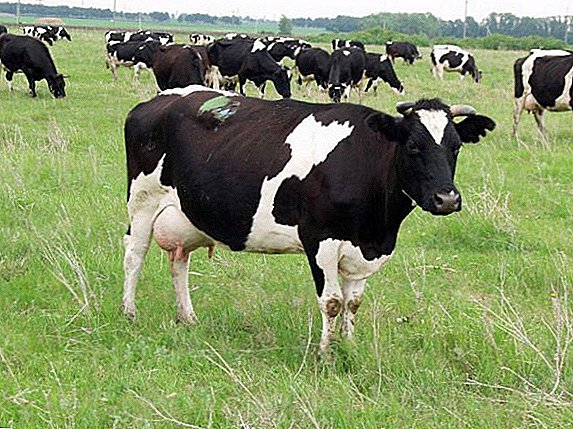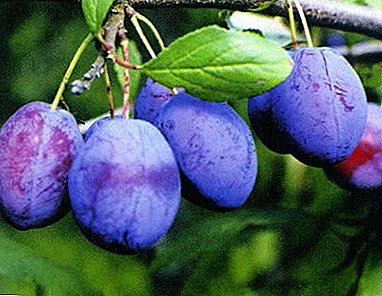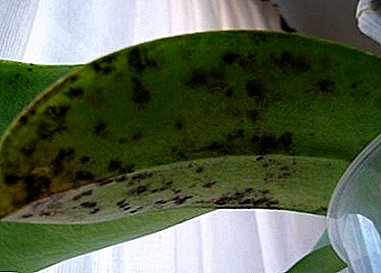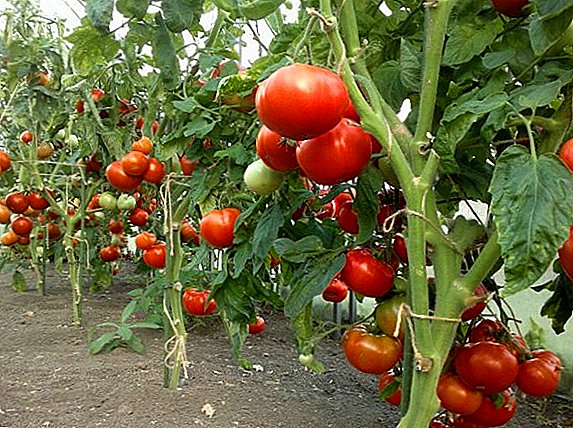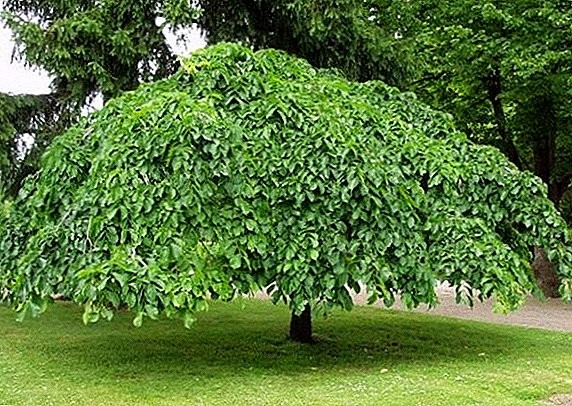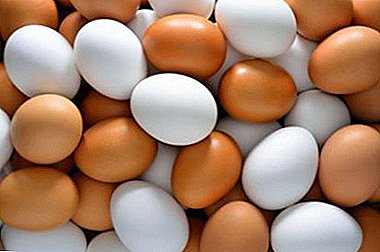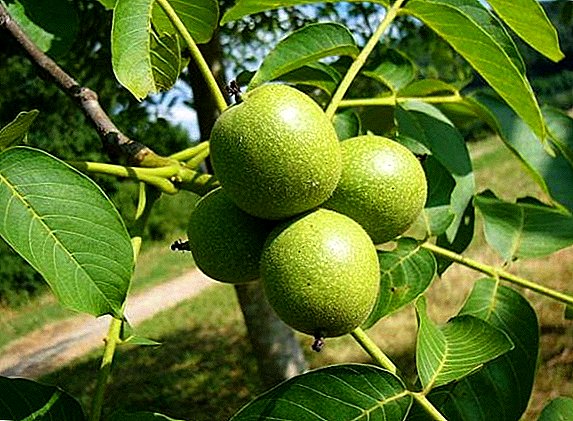 From antiquity to the present day, walnut is called the "tree of life". Due to the unique composition rich in vitamins, micro and macro elements and other useful substances, the nuts are used in the treatment of many diseases, restore loss of strength, satisfy hunger. To saturate the body with useful elements is enough a few nuts a day.
From antiquity to the present day, walnut is called the "tree of life". Due to the unique composition rich in vitamins, micro and macro elements and other useful substances, the nuts are used in the treatment of many diseases, restore loss of strength, satisfy hunger. To saturate the body with useful elements is enough a few nuts a day.
Rules for buying walnut seedlings
Walnut cultivation begins with the right choice of planting material. The walnut has one interesting feature: the plant first gives all its strength to the development of the root system, then to the growth and development of the trunk and green mass. Therefore, seedlings that can take root and give offspring in the future are not developed shoots with leaves, but a powerful root system. A sapling with leaves, on the contrary, may not settle down, besides, when sowing, saplings are pruned so that the food goes exclusively for rooting.
A healthy seedling must be strong, with developed roots (the root system of the nut is pivotal). It should meticulously inspect the bark of the plant, it should not be any mechanical and other damage.
Important! If a walnut seedling has too dry bark, rotten and soft roots, you should refuse to buy it - the plant is sick.
 The best way to choose a sapling is to contact a nursery, where you can choose high-quality healthy planting material. And then, in the nursery, they will tell you whether the seed originates from the plant or is grafted. From the grafted seedling, if it is also skoroplodny, the harvest can be obtained in the third year, and from the seed one in the tenth, not earlier.
The best way to choose a sapling is to contact a nursery, where you can choose high-quality healthy planting material. And then, in the nursery, they will tell you whether the seed originates from the plant or is grafted. From the grafted seedling, if it is also skoroplodny, the harvest can be obtained in the third year, and from the seed one in the tenth, not earlier.Choosing a place to plant a walnut
Walnut loves bright sunshine, with plenty of light, the crown becomes sprawling, thick. A walnut is a powerful plant, the height of a tree is up to 25 meters, and the trunk diameter often reaches seven meters. The tree can grow on a small slope, with 18 degrees of slope.
It is undesirable to plant a nut on dense, poorly aerated and swampy soils. The soil for a walnut is recommended with a uniform content of sand and clay, the location of groundwater is close to the surface.
As already mentioned, the nut grows high and spreading a tree, when planting it should be noted that it will close the light to the plants growing nearby. If this happens, these plants should be transplanted to another place.  Where to plant a walnut on the plot - the southern or southwestern side of the plot, protected from the wind, will be the best place for the nut. When picking up a plot for a nut, do not plant it near the house or farm buildings, the roots of the plant, if they grow, can damage the foundation of the building. It is not necessary to plant close to the fence.
Where to plant a walnut on the plot - the southern or southwestern side of the plot, protected from the wind, will be the best place for the nut. When picking up a plot for a nut, do not plant it near the house or farm buildings, the roots of the plant, if they grow, can damage the foundation of the building. It is not necessary to plant close to the fence.
Did you know? Pliny's mention of nuts has been preserved. In them, he writes that the plant came to Greece from the gardens of the Persian king Cyrus, then from trade expeditions from Greece to Rome, and from there to the territory of modern France, Switzerland, Bulgaria and Germany. In America, the nut came only in the XIX century.
Preparatory work before landing
Walnut will not require a lot of attention when growing and caring for yourself, if you carefully prepare the seedlings and place for planting. A place for planting should be cleaned from plant debris, loosen and level. If the soil does not meet the requirements, it can be replaced with a more fertile part.
 A planting pit is dug just before planting in order to preserve the amount of moisture the plant needs, since it is not desirable to pour water into the pit. Its depth depends on the length of the roots, it should be dug deeper so that the roots are conveniently located and not broken.
A planting pit is dug just before planting in order to preserve the amount of moisture the plant needs, since it is not desirable to pour water into the pit. Its depth depends on the length of the roots, it should be dug deeper so that the roots are conveniently located and not broken.
Saplings will need a quality feed. The walnut fertilizer is made from the following components: a manure bucket, 400 grams of wood ash, 200 grams of superphosphate. This nutrient mixture is placed on the bottom of the pit, and when planted, it is sprinkled with soil; contact of the roots with the fertilizer is undesirable.
The process of planting seedlings and the distance between them
The most favorable time when planting walnut seedlings is spring. The plant will have time to take root and grow strong until the winter frosts, which can destroy young trees.
Saplings before planting need to inspect, if there are damaged, rotted or dried roots, they are cut. To facilitate and speed up the rooting process, the roots of seedlings are dipped in a clay mash with the addition of a growth stimulator. Talk prepared from clay, rotted manure and water (3: 1: 1), density - like that of sour cream.
Walnut planting is carried out slowly, the roots gently straighten, it is desirable to give them a horizontal position. Then, starting from the lowest roots, gradually poured over the soil. As a result, the upper part of the roots should be six to seven centimeters below the ground surface. The soil of the circle is gently tamped down, a shallow watering groove is made around the circle. Planted nuts abundantly watered, about 15 liters of water per tree. Since the crown grows strongly in diameter, the tree does not need neighbors closer than five meters. 
Walnut Care Tips
Walnut, subject to the rules of planting and timely care, will respond to a good harvest. Caring for a plant is not complicated, the main thing is to carry out the procedures on time and know some features. For example, soil care, weeding, loosening are carried out no deeper than five centimeters, since the plant's upper roots are located close to the surface.
Did you know? The benefits of walnuts for brain activity were known to the priests of ancient Babylon. The high-ranking gentlemen forbade the common people to eat nuts for fear that they would become too clever. Walnut, according to many scholars and researchers of antiquity, is one of the top ten cultivated plants by humans.
Preventive treatment of trees from diseases and pests
In early spring, the plant requires some preventive measures: from the trunk and skeletal branches of the nut, it is necessary to remove the bark that has died during the winter and the washed-off whitewash; cleaned surfaces should be washed with a solution of copper sulfate (3%); whitewash refresh.
In the spring, while the kidneys are still asleep, the tree and the soil of the circle around the trunk are sprayed with Bordeaux one-percent liquid to prevent diseases and pests.
In the summer, to prevent the appearance of pests and diseases around the nut, the soil is cleaned, the tree itself from time to time should be carefully examined for insects, any suspicious spots on the bark and foliage. If found, treat immediately with fungicides (in case of signs of illness) or insecticides (with the appearance of insects).
 After harvesting and leaf fall, trees are treated again for prophylaxis; the same means can be used. Experienced plant growers recommend using a seven percent urea solution instead of Bordeaux liquid and copper sulphate. This solution is multifunctional, it is at the same time escape from insects, has a fungicidal effect and is a nitrogen fertilizer.
After harvesting and leaf fall, trees are treated again for prophylaxis; the same means can be used. Experienced plant growers recommend using a seven percent urea solution instead of Bordeaux liquid and copper sulphate. This solution is multifunctional, it is at the same time escape from insects, has a fungicidal effect and is a nitrogen fertilizer.
Important! Since the nut needs a period of growth in nitrogen, it is better to process it with urea in the spring.
Watering rules
After a winter with little precipitation, or even no snow, moisture is vital for a nut. Water the tree well, up to about twenty liters of water. Under normal rainfall, the nut is watered once every two months in the spring. In summer, with heat and no rain, the need for watering increases. Approximately from May to July walnut trees are watered twice a month, with three or four buckets of water per tree, the lack of moisture can affect the walnut yield.
Loosening the soil does not need to be carried out after each watering, the nut does not like it. If there are frequent rains in the spring and in the summer, it is not worth watering, the walnut likes moisture, but due to the structure of the root system, its excess will be disastrous. Reduce watering for trees above four meters, their root system pulls moisture from the deep layers of the soil.
In late summer, watering is reduced.  If the autumn is not rainy, plentifully watered, it is necessary for wintering. To avoid cracking and the formation of a rough earth crust, mulching is necessary. In this way, the soil will also avoid drying out on particularly hot days. Mulch is made from straw or sawdust, peat in a five-centimeter layer.
If the autumn is not rainy, plentifully watered, it is necessary for wintering. To avoid cracking and the formation of a rough earth crust, mulching is necessary. In this way, the soil will also avoid drying out on particularly hot days. Mulch is made from straw or sawdust, peat in a five-centimeter layer.
Feeding trees
In May, it is time to fertilize and the question arises: what to feed the walnut with? Older trees older than three years old need up to six kilograms of ammonium nitrate, nut fed in early spring or in the first days of summer.
In late June, for better growth of shoots, their tops pinch and feed the tree with phosphates and potassium, adding trace elements. There are fertilizers for fruit trees with a complex composition. The tree that bears fruit needs for the whole season 10 kg of superphosphate, 10 kg of ammonium sulfate, 3 kg of potassium salt and 6 kg of ammonium nitrate.
Important! Biological fertilizers can be used: planting siderats (lupine, oats), which are placed in the ground in autumn, can be planted between the walnut trees.
When and how to prune
In the first three years of the life of the nut you need to form its trunk and crown. Every year, lateral branches are cut near the tree. Sanitary or formative pruning of walnuts is carried out with a sharp tool so as not to harm the plant, do not leave burrs.

For the formation of the crown, the best period is when the tree has reached one and a half meters of growth, with the stem up to 90 cm and the height of the crown up to 60 cm.
When forming the crown, branches are shortened by 20 cm, leaving about ten skeletal shoots, cleaned from germinating shoots and shtamb. The final shape of the crown will be achieved in four to five years, but after that, it will be necessary to cut only the branches that prevent the growth of the main shoots that grow inwards and thicken the crown too much.
The basic rules for trimming a walnut tree include:
- The procedure is carried out either in spring before the beginning of active movement of juices, or in autumn;
- In the autumn, pruning of dry and damaged branches is done so that the tree does not give up in winter a valuable food for the obviously doomed shoots;
- All sections after the procedure should always be treated with garden pitch to avoid infections.
Walnut Wintering
After harvesting and autumn pruning, the area needs to be cleaned, all plant residues removed, since it is in them that the harmful insects overwinter. Inspect the trees, branches and bark, it also often overwinter pests, lime tree trunk. It is advisable to carefully prepare young trees and saplings of the current year for the winter: it is necessary to cover the tree trunk circle with mulch. It is possible to cover with manure, but so that it does not come into contact with the bark, the trunks of the nut are wrapped with sacking, and then spruce branches can be laid on the tree trunk.
How to collect and store crops
The harvest of nuts ripens in late summer - early autumn. You can collect those nuts, green peel which cracks. It is not recommended to remove green fruits: they don’t even have half the useful substances of a ripe walnut, an unripe walnut ripens poorly and is not stored for a long time. As the fruits ripen unevenly, they are collected in batches as they ripen.  In order not to lean over each nut and not throw a stick in fruitless attempts to knock down the fruits firmly on the petioles, risking damage to the bark of the plant and simply wasting time, the gardeners came up with some tools: the usual long pole (length depends on the plant height) with attached linen or plastic bag on the end.
In order not to lean over each nut and not throw a stick in fruitless attempts to knock down the fruits firmly on the petioles, risking damage to the bark of the plant and simply wasting time, the gardeners came up with some tools: the usual long pole (length depends on the plant height) with attached linen or plastic bag on the end.
Fruits that have fallen to the ground, you need to collect as soon as possible. When a walnut rind rots, the rot can be imprinted on the shell, and this will affect storage. It is desirable to collect nuts in dry weather.
To send the nuts for long-term storage, they are peeled and dried. Dried under a canopy in dry weather or in the house, scattered on fabric or paper. It usually takes a week to dry, turn the nuts from time to time so that they dry out evenly, as excess moisture may affect storage.
as excess moisture may affect storage.
Nuts without shell are stored for about half a year in fabric bags or glass containers in a dry place. Shelled nuts are also stored in a dry place: in a box, paper, or cloth bag, but much longer.
About the benefits of walnut, its medicinal properties knew long before the beginning of our era. In our time, the dignity of the nut is also appreciated. Both traditional and traditional medicine use the properties of the nut and recommend it to be used by both adults and children.



